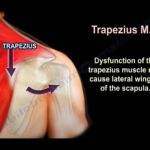Courtesy: Prof Nabil Ebraheim, University of Toledo, Ohio, USA
Anatomy of Trapezius muscle
Trapezius is a large superficial muscle that extends from the back of the skull,back of the neck and back of the thorax.
Origin:
The upper fibres of the trapezius muscle arise from the external occipital protruberance and the medial third of the superior nuchal line.The middle fibres arise from the ligamentum nuchae and the spinous process of c7. The lower fibres arise from the spinous process and supra spinous ligaments of all 12 thoracic vetrbrae.
Insertion:
The trapezius is inserted into the lateral 3rd of the clavicle and from the acromion process and spinous scapula.
Function:
The trapezius muscle allows for rotation and lift of the scapula. This function of the trapezius muscle may cause lateral winging of the scapula. Winging can occur after radical neck surgery but it usually occurs after biopsy or tumor dissection. The spinal accessory nerve will be injured and the patient will have difficulty with overhead activity. If injury to the spinal accessory nerve occur early , explore the nerve. If injury is late do a muscle transfer.
Innervation
The spinal accessory nerve provides the motor innervation to the sternocleidomastoid and the trapezius muscle. The spinal accessory nerve courses obliquely across the posterior triangle on the surface of the levator scapula muscle and reaches the trapezius. Within the posterior triangle of the neck, the nerve is vulnerable since it is superficial and only covered by skin and subcutaneous fascia. Extreme caution should be taken for any surgical procedure done in the posterior triangle of the neck.

Leave a Reply